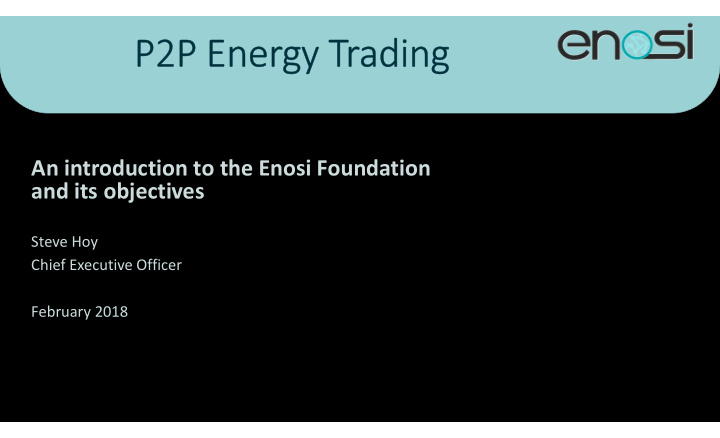



P2P Energy Trading An introduction to the Enosi Foundation and its objectives Steve Hoy Chief Executive Officer February 2018
Where do we come from? • A core team with over 200 years experience in the solar energy, utilities technology and finance industries • Already engaged with partners in Retail Energy, Solar Research and Cryptocurrencies
What will we do? • The Enosi Foundation aims to disrupt the power industry with an open-source Peer-to-Peer energy trading platform deployed on the Ethereum blockchain.
Blockchain in the Electricity Industry Our Initial Focus Source: :https://www.indigoadvisorygroup.com/blockchain
What is Peer-to-Peer Energy? • True P2P energy trading allows prosumers to sell their excess generation to consumers in a market that does not rely on their current utility • The P2P market settles first but does not have to balance • The ‘overs and unders’ are traded in the upstream wholesale market
Why Blockchain? • The P2P market must to ensure the same kWh is not sold twice Criteria P2P Energy Score – just as Bitcoins cannot be spent twice. Data Classification High • Current processes are fraught with Business Network involved Medium multiple conflicting ledgers (eg Consensus (Agreement) High Australian metering data held by MC, Provenance (Audit) High MDP, FRMP, DNSP and AEMO at least!) Immutability (Tamper) High • The process automation opportunity Smart Contract (Process) Medium with smart metering and IoT devices is substantial Source: https://arena.gov.au/assets/2017/10/Final-Report-MHC-AGL-IBM-P2P-DLT.pdf
What’s wrong with most models? 1 - not disruptive Enosi is clearly not the first to pursue P2P • In every case these companies are trying to pursue P2P from within the current industry structure • Requires cooperation of incumbent companies, microgrid models, special tariffs for T&D, or regulatory changes to become sustainable • By contrast Enosi’s model can be implemented straight away by any neo-retailer to enable a P2P market between their customers • We will provide a fully open source platform that can be tailored by local energy experts to meet the requirements of the thousands of individual energy markets globally
What’s wrong with most models? 2 – it’s not just about money Ongoing research by our partner Solar Analytics has confirmed that energy customers value: 1. Value 2. Community 3. Provenance 4. Engagement Most models focus exclusively on the first point, ignoring the facts that customers will pay the same or even more for • energy shared within their community, or • proven to be from a local and/or green source • the ability to engage, understand and control their energy
Where does the Enosi Platform fit? The core Enosi protocols will • Replace existing metering, billing and settlement functions • Support new capabilities in the areas of: • P2P energy exchange, • proof of energy provenance, and • community energy programs. Enosi dApps will be available to neo- retailers and partners to • assist in customer engagement functions • support wholesale market optimisation.
What’s possible? Over 30 % reduction in the Retail components of your energy bill. Reduce the wholesale energy cost of goods sold by substituting local energy resources for wholesale generation in times of peak pricing Pressure on network tariffs to drive regulatory change Long term potential for energy bills to halve!
Introducing the JOUL • To facilitate the smart contracts and the near-real time settlement of electricity trading, a new ERC20 crypto coin will be created called the JOUL • The JOUL will tokenise the production and consumption of household electricity, as well as enabling the tokenholder to access the system functions.
The legal and regulatory challenges - a non-exhaustive list • Peer-to-Peer trading • How might DER proliferation and P2P impact network charges and tariff structures and incentive schemes? • How should regulators view Long Run Marginal Cost where demand is met by increasing solar? • What is the value of peer-to-peer trading and how should the costs be distributed? • Energy tokens • A security, a product? a currency? • Jurisdictional differences • Cryptocurrency trading controls • Data Access and Privacy • Customers should control their own data • Blockchain provides the opportunity to anonymise while still trusting
More Information? Contacts: Join us on line Steve Hoy - CEO Web steve@enosi.io www.enosi.io 0402 892832 Bill Barden – Token Sales bill@freshwatercp.com Telegram Channel 0400 977294 https://t.me/enosi_joul
Recommend
More recommend